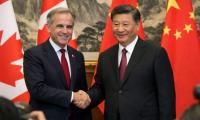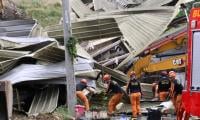Gateway to prosperity
Pakistan’s new gateway to economic prosperity – the Dhabeji Special Economic Zone – is in the making. Chairperson of the PPP and Foreign Minister Bilawal Bhutto-Zardari laid its foundation stone in the suburbs of Karachi last month, with the promise of an industrial revolution in the country and a belief that the worst times for the economy and the country are over.
Dhabeji is a small town in the suburbs of Karachi. Administratively, it falls under the jurisdiction of District Thatta. Those travelling from Karachi to Thatta through the National Highway will find a fast-growing small town of Dhabeji with many new industrial units as soon as they cross the Sassui Toll Plaza. This highway itself is one of the best examples of public-private partnership (PPP) in the province (included by the late Mohtarma Benaizr Bhutto in her 1993 election manifesto), which was successfully launched and completed by the Sindh government in recent years.
The PPP-led provincial government has also successfully constructed the Karachi-Thatta dual carriageway, Jhirk Mulla Katiyar Bridge over the Indus, and launched coal mining in Thar, beside other such project interventions. As a result, the Public Private Partnership Unit of the Sindh government has been recognized as the sixth best-performing unit in Asia by the International Intelligence Unit of The Economist. This is a huge acknowledgement.
To promote public-private partnerships, the Sindh government has established the Sindh Economic Zones Management Company (SEZMC) under the Company’s Act, 2017 to institutionally facilitate, promote, encourage and enhance the industrial base. The launch of the Dhabeji Special Economic Zone (DSEZ) is one such SEZ.
The provincial government has also allotted 1,530 acres of land to develop the DSEZ, which has easy access to Port Qasim. This may enable the import of raw material and the export of finished goods without incurring major inland transportation costs and save time. It also has easy access to the Karachi airport – 35km via the National Highway – enabling safe travel of foreign workers and management personnel.
The DSEZ’s development work is planned to be completed within 18 months. Situated approximately 10 km from Port Qasim, it can serve as a storage hub for Port Qasim, facilitating efficient logistics. Special packages have also been announced to incentivize people working in the economic zone. These include a one-time exemption from tax and customs duty on the import of capital goods, as well as income tax exemption for a period of 10 years. These measures are designed to promote investment, boost economic activity and attract business.
Most importantly, it is hoped that this DSEZ will attract significant investment, estimated to be around $5 billion. It will create 150,000 employment opportunities and also contribute to poverty alleviation in the region.
The DSEZ is not only a flagship project of the Sindh government but also a CPEC-priority project. It is one of the six CPEC-proposed SEZs in Pakistan. This year, we are marking the 10th celebration of its launch in Pakistan.
CPEC in actual was pioneered and instrumentalized much before its formal launch, by former president Asif Ali Zardari. He made frequent visits to China as president and negotiated various economic projects for the development of Pakistan, particularly in the industrial and infrastructure, power, and trade sectors. His frequent visits bore fruit in the shape of CPEC projects under which the Thar Coal-fired Power Project already started power generation. Now the Dhabeji SEZ is being developed, while various road projects have been completed.
The DSEZ is a significant component of CPEC and will be linked to the historic Keti Bandar, which connects to the Gwadar Port and other ports. Keti Bandar was constructed ages ago following the closure of the historic Shah Bandar, which was a significant trading hub at the time. Shah Bundar and Keti Bundar have remained historic ports and had immense significance during the Mughal and British era.
The late Zulfikar Ali Bhutto and Benazir Bhutto initiated various projects for the rehabilitation of Keti Bandar and Shah Bandar during their terms. In 1994, Benazir Bhutto also envisioned constructing a power plant using Thar coal and establishing a road network in the area. Feasibility reports were prepared, and plans were made for a power station and a port at Keti Bandar.
Unfortunately, everything was shelved as her second government was dismissed in 1996. Now, her dream projects from the Thar coal project to linking Keti Bundar with the rest of the country are being completed by her proud son; Dhabeji is the latest example and the economic zone is likely to become a dream destination for investors in Sindh.
Sindh has come a long way – from being the harbinger of the Indus civilization to becoming an economic hub of Pakistan. With its glorious past, strong industrial base, developed infrastructure, two international ports and strong financial institutions, Sindh provides an ideal investment opportunity to both local and foreign investors.
As per data available on the DSEZ website, Sindh has approximately 350 km of coastline with thick mangrove forests. Forty-eight per cent of all fish export from Pakistan is from Sindh. Also, 65 per cent of fresh fish resources and 100 per cent of brackish water fish resources are located in Sindh.
Thar in Sindh is estimated to have the largest coal reserves – 185 billion tonnes – in the world. Besides this, around 60 per cent of the country’s oil fields and 44 per cent gas fields are located in Sindh. They contribute around 56 per cent of the total oil production and 55 per cent of Pakistan’s daily gas production. The province also has a huge potential for renewable energy with a 60 km-wide and 180 km-long wind corridor.
These are some top attractions to invest in Sindh, including the new and emerging base at Dhabeji. Investors, industrialists, and traders should explore the DSEZ, which offers strategic location, meticulously planned infrastructure, supportive policies, and an unparalleled platform for businesses to flourish not only in Dhabeji and Sindh, but also in the rest of Pakistan.
The writer is a freelance contributor, based in Karachi. He tweets:
@HullioSikandar
-
 Canadian PM Visits China After A Decade Of Diplomatic Strain: What Deals Are In Focus?
Canadian PM Visits China After A Decade Of Diplomatic Strain: What Deals Are In Focus? -
 New York Plans Limited Rollout Of Self-driving Taxis
New York Plans Limited Rollout Of Self-driving Taxis -
 Sarah Ferguson Faces Painful Choice Between Peace, Family Bond
Sarah Ferguson Faces Painful Choice Between Peace, Family Bond -
 Nvidia Clarifies ‘no Upfront Payment Needed For H200 Chips Production’
Nvidia Clarifies ‘no Upfront Payment Needed For H200 Chips Production’ -
 Africa First: Nigeria Set To Approve Landmark AI Rules For Digital Economy
Africa First: Nigeria Set To Approve Landmark AI Rules For Digital Economy -
 WhatsApp Tests Built-in Supervision Feature Long Missing From The App
WhatsApp Tests Built-in Supervision Feature Long Missing From The App -
 Iceberg A-23A Turns Blue As Scientists Warn Collapse Is Imminent
Iceberg A-23A Turns Blue As Scientists Warn Collapse Is Imminent -
 FIFA Selects Stats Perform For Betting Data And Live Streaming
FIFA Selects Stats Perform For Betting Data And Live Streaming -
 Is Jessica Simpson Really Joining 'The Bachelorette'?
Is Jessica Simpson Really Joining 'The Bachelorette'? -
 Brayden Point Injury Raises Concern After Early Exit For Tampa Bay Lightning
Brayden Point Injury Raises Concern After Early Exit For Tampa Bay Lightning -
 Meghan Trainor Addresses 'toxic Mom Group' Rumours Again
Meghan Trainor Addresses 'toxic Mom Group' Rumours Again -
 Mattel Autistic Barbie Doll Aims To Boost Representation And Inclusion
Mattel Autistic Barbie Doll Aims To Boost Representation And Inclusion -
 William Makes Calculated Move To Future-proof His Public Role Amid Harry Return
William Makes Calculated Move To Future-proof His Public Role Amid Harry Return -
 Elijah Wood Breaks Silence On Possible Return To New 'Lord Of The Rings' Film
Elijah Wood Breaks Silence On Possible Return To New 'Lord Of The Rings' Film -
 Aaron Rodgers Wife: What The NFL Quarterback Has Said About His Marriage
Aaron Rodgers Wife: What The NFL Quarterback Has Said About His Marriage -
 Buckingham Palace Shuts Down Claims It Can Step In On Harry’s Security
Buckingham Palace Shuts Down Claims It Can Step In On Harry’s Security



